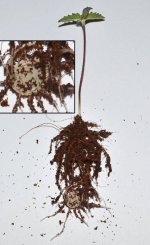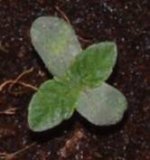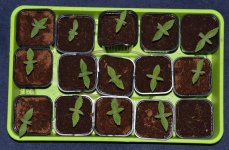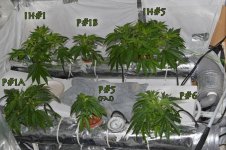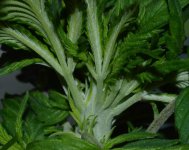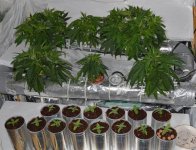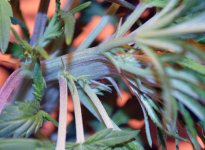-
ICMag with help from Phlizon, Landrace Warden and The Vault is running a NEW contest for Christmas! You can check it here. Prizes are: full spectrum led light, seeds & forum premium access. Come join in!
You are using an out of date browser. It may not display this or other websites correctly.
You should upgrade or use an alternative browser.
You should upgrade or use an alternative browser.
Only cause you mentioned it. Thought it was a few month old. Let's see if we can make it to page 6 before 2024.Y'all realize that this thread is now nearly 10 years old?
I transplanted the 14 ICExCH whorl-test seedlings to individual containers. They are in coco, I normally don't grow like this, just for a quick test. I can always transplant them to DWC (done from various media) if I want to keep some.
The small one is from the double yoker, interesting one, first set of leaves have nearly smooth edges. I expect that to change in newer leaves, but still curious. The seemingly empty one is its unicot twin.
Check out the spiral of the taproot of one the seedlings, inheritable trait or just circumstantial coincidence (was in shallow container)?
Anyway, it will probably take 3-5 weeks before I will post the results of the whorled frequency test. In the meantime I will occasionally update on the ones I got in the flower closet, hopefully being able to show how the branches start whorling after removing the terminal shoot.
Attachments
The 14 whorled frequency test seedlings are working on their 2nd set and still all regular opposite. All the previous whorled were regular too at this stage so still waiting. I also found some space for these 14: my flower closet... I'm going to push back my tubes a little to make some space for them.
P#1A started flowering... on 20/4. At first I thought it was just showing preflowers from maturity, but it also reverted back to 5, 3, and eventually 1 leaflet per leaf. I manage my light schedule manually, there's no way the light schedule caused it too flower. I considered removing and replacing it, but its root are already mixed up with those of P#5, the fasciated plant. Had some hopes it would reveg, still has a few days, a weeks tops before I switch to 12/12.
P#1B is a clone from the same plant, taken nearly a week later from the sexed clone-mom, but finally started growing. By not topping it it should work out with the two ICExCH plants next to it.
P#6 turns out to be a female, so got a bit of luck with that one. Regular opposite phyllotaxy. Its preflowers started like little ribbons, almost like stipules, but spawned some pistils eventually.
P#5 is the fasciated plant, it's not as vigorous as some of the others. New growth is healthy and it is growing but not as fast as I'm used to. As you can see in the image below, it has quite a few more than 3 or 4 leaves at the same level, seems like 8 or 9.
At this point the P plants (chunk x CH) don't look like keepers, maybe the buds will surprise me.
IH#5 is still doing awesome. Will try to self it, backcross, and if there's a fast whorled male in those 14 I may be able to use some of that for a small malexfemale whorled test.
P#1A started flowering... on 20/4. At first I thought it was just showing preflowers from maturity, but it also reverted back to 5, 3, and eventually 1 leaflet per leaf. I manage my light schedule manually, there's no way the light schedule caused it too flower. I considered removing and replacing it, but its root are already mixed up with those of P#5, the fasciated plant. Had some hopes it would reveg, still has a few days, a weeks tops before I switch to 12/12.
P#1B is a clone from the same plant, taken nearly a week later from the sexed clone-mom, but finally started growing. By not topping it it should work out with the two ICExCH plants next to it.
P#6 turns out to be a female, so got a bit of luck with that one. Regular opposite phyllotaxy. Its preflowers started like little ribbons, almost like stipules, but spawned some pistils eventually.
P#5 is the fasciated plant, it's not as vigorous as some of the others. New growth is healthy and it is growing but not as fast as I'm used to. As you can see in the image below, it has quite a few more than 3 or 4 leaves at the same level, seems like 8 or 9.
At this point the P plants (chunk x CH) don't look like keepers, maybe the buds will surprise me.
IH#5 is still doing awesome. Will try to self it, backcross, and if there's a fast whorled male in those 14 I may be able to use some of that for a small malexfemale whorled test.
Attachments
Good news, P#1A seems to be back in veg mode, increasing leaflets again. It's going to look weird probably.
P#5 the fasciated is fascinating but not a very vigorous plant. I'll let it flower but not going to create seeds with it.
I'm not sure if I'm going to be able to observe any more whorling on the IH plants (#1 and #5). They seem too mature, too far alternating to start whorling on the branches after the terminal shoot was topped (which did clearly happen with the plants from which I took these clones).
P#6 the regular opposite caught up nicely.
P#5 the fasciated is fascinating but not a very vigorous plant. I'll let it flower but not going to create seeds with it.
I'm not sure if I'm going to be able to observe any more whorling on the IH plants (#1 and #5). They seem too mature, too far alternating to start whorling on the branches after the terminal shoot was topped (which did clearly happen with the plants from which I took these clones).
P#6 the regular opposite caught up nicely.
Attachments
Fasciated P5:

The canopy of the 8 or so leaves that spawn next to each other are completely overshadowing the lateral shoots with multiple layers of otherwise beautiful leaves:

Following is one of the budsites of IH#1, the former regular opposite control plant that started whorling later.

The canopy of the 8 or so leaves that spawn next to each other are completely overshadowing the lateral shoots with multiple layers of otherwise beautiful leaves:
Following is one of the budsites of IH#1, the former regular opposite control plant that started whorling later.
The fasciated plant spawned a regular bud site from the messy terminal:

Fascinating but not a good yielder.
2nd generation clone from IH#5 the strongest whorler:

I have no reason to believe there is a link between whorled phyllotaxy and "low-yielding phenotypes" as suggested by someone above. Also contrary the experience of others, I have no doubt mine will do just fine.
IH#5:



Left and right in the back, the lower ones, are IH#1 and IH#5.
The P#1A left in the front turned out pretty nicely despite its reveg episode. Too many buds sites on it, but all small and not too leafy.
I wasn't happy with the veg rate in the coco bottles of the those 14 whorl ratio test plants and needed the space so I cancelled that for now. I need to find a male for IH#5 too mate with anyway so will be able to check the ratio later this fall anyway.
I will be trying the currently frozen pollen from the quad-whorled male on the tri-whorled IH#5 soon to see if I can make that backcross. Not sure if I'll be able to get pollen from IH#5 itself in time, might have to do that next round.
Fascinating but not a good yielder.
2nd generation clone from IH#5 the strongest whorler:
I have no reason to believe there is a link between whorled phyllotaxy and "low-yielding phenotypes" as suggested by someone above. Also contrary the experience of others, I have no doubt mine will do just fine.
IH#5:
Left and right in the back, the lower ones, are IH#1 and IH#5.
The P#1A left in the front turned out pretty nicely despite its reveg episode. Too many buds sites on it, but all small and not too leafy.
I wasn't happy with the veg rate in the coco bottles of the those 14 whorl ratio test plants and needed the space so I cancelled that for now. I need to find a male for IH#5 too mate with anyway so will be able to check the ratio later this fall anyway.
I will be trying the currently frozen pollen from the quad-whorled male on the tri-whorled IH#5 soon to see if I can make that backcross. Not sure if I'll be able to get pollen from IH#5 itself in time, might have to do that next round.
Chappi
Well-known member
I have a seedling I'm considering growing out but it doesn't seem worth it when compared to another healthy seedling. The surface area of one regular leaf seems to equal to three of the leaves on the tricot or whatever you call it.
Should I keep it around or cull it?
Should I keep it around or cull it?
Last edited:
I have a seedling I'm considering growing out but it doesn't seem worth it when compared to another healthy seedling. The surface area of one regular leaf seems to equal to three of the leaves on the tricot or whatever you call it.
Should I keep it around or cull it?
I don’t see the relevance of your comparison, obviously the regular leaves always start out smaller than the cotyledons but will outgrow them sooner than later.
And yes, a tricot, which also means it will have whorled phyllotaxy but may grow out of it (after a few nodes or grow normal branches). If it continous to be whorled it will actually grow faster, exponentially.
Of course, keep it and grow that beauty.
N.Degrass Tyson
New member
polypoid/mixoploidism or phyllotaxis
polypoid/mixoploidism or phyllotaxis
ya sure thats from whorled phyllotaxy and not a polyploid/mixoploid? all these traits are polyploid traits. thicker stems, vigorous growth, more nodes, tighter nodes horizontal growth terminal buds and even the poor taste and quality buds. Ive heard that if you breed it with a diploid (normal chromosones) it will create a more stable somewhere in between plant that will be infertile (think no hermy will ever affect her).
polypoid/mixoploidism or phyllotaxis
ya sure thats from whorled phyllotaxy and not a polyploid/mixoploid? all these traits are polyploid traits. thicker stems, vigorous growth, more nodes, tighter nodes horizontal growth terminal buds and even the poor taste and quality buds. Ive heard that if you breed it with a diploid (normal chromosones) it will create a more stable somewhere in between plant that will be infertile (think no hermy will ever affect her).
ya sure thats from whorled phyllotaxy and not a polyploid/mixoploid? all these traits are polyploid traits. thicker stems, vigorous growth, more nodes, tighter nodes horizontal growth terminal buds and even the poor taste and quality buds. Ive heard that if you breed it with a diploid (normal chromosones) it will create a more stable somewhere in between plant that will be infertile (think no hermy will ever affect her).
Whorled phalotaxy is fairly common.
Multi-ploid cannabis, however, is almost as rare as unicorn poop, outside of labs.
Hi friends. Guess it's my turn to resurrect this thread and keep this informative discussion going. I had an interesting thing happen recently. Pollinated an otherwise pretty standard Ace PCK with another normal-looking CBG PanamaDC. Recently popped the beans about 2 weeks ago and so far I've identified around 6 or 7 of 12 total plants (11 in veg, one straight in the flower tent) that appear to have this trait. Around the 3rd node or so, I'm getting 3 or 4 fan leaves, and in the case of 3, one of them looks like it was supposed to be 2, but fused into one. So at least 50%. Incidentally, I have a cutting of Nirvana Sterling Haze in that same veg tent that is showing 3. But the cutting was also taken when she just began to flower, so that behavior when revegging isn't as much of a surprise.
But I'm really surprised with the frequency of the trait in this F1. Is there any possible chance that environmental factors could play a part? Nothing unusual in the grow, really. Little cabinet with a blurple led on 18/6. Peat/perlite/ewc/amendments.

Here's the one with what appears to be fused fans. That middle blade is actually part of the lower fan leaf, so it's an even numbered fan with no distinct middle finger (heh).

It's weird, but interesting. I'll see how they do. Oh, and these two were topped after I noticed the trait.
But I'm really surprised with the frequency of the trait in this F1. Is there any possible chance that environmental factors could play a part? Nothing unusual in the grow, really. Little cabinet with a blurple led on 18/6. Peat/perlite/ewc/amendments.
Here's the one with what appears to be fused fans. That middle blade is actually part of the lower fan leaf, so it's an even numbered fan with no distinct middle finger (heh).
It's weird, but interesting. I'll see how they do. Oh, and these two were topped after I noticed the trait.
BumblebeeTuna
New member
If you don't want to sound like a newb, you can just say whorled. Phylotaxy isn't a part of the designation, it just means the way the leaves are arranged. Whirled leaf arrangement. Saying whorled phylotaxy is like saying I have a penis genitals.
xet
Active member
That salutation might be the new mandatory brainwashing for avoiding so-call hate speech lawsSaying whorled phylotaxy is like saying I have a penis genitals.
goingrey
Well-known member
LOLIf you don't want to sound like a newb, you can just say whorled. Phylotaxy isn't a part of the designation, it just means the way the leaves are arranged. Whirled leaf arrangement. Saying whorled phylotaxy is like saying I have a penis genitals.
All day I've had this enigmatic thread title in my mind for some reason. Whorled phyllotaxy, what does it mean.
So it is an arrangement of leaves (phyllotaxy) where three or more of them are attached to the same part of the stem (whorl).
Dropped a couple shots in this old skeleton that surfaced to dispel any rumor that they don't yield.
Bloom was initiated when the whorled sets no longer maintained nodal symmetry but rather started extending in a whirled patter up the apical meristem. At harvest it was 5' in height with a 10' diameter. I donated it to another who finished it with a seed run in 2010.
The genetics have been continually bred over the past 13 years to increase the dominance of this trait. Subsequent generations where chosen based upon vitality, pest resistance, and the breeders individual taste preferences. At this point the genetics are pretty stable and there is about a 23% whorled taxonomy present in the seedstock.


Bloom was initiated when the whorled sets no longer maintained nodal symmetry but rather started extending in a whirled patter up the apical meristem. At harvest it was 5' in height with a 10' diameter. I donated it to another who finished it with a seed run in 2010.
The genetics have been continually bred over the past 13 years to increase the dominance of this trait. Subsequent generations where chosen based upon vitality, pest resistance, and the breeders individual taste preferences. At this point the genetics are pretty stable and there is about a 23% whorled taxonomy present in the seedstock.


time to add another example to the list
one of these oddities has popped up in my grow chamber
thing is it didn't start out that way, 2 cotyledon leaves, 2 first true leaves
and then it flipped over to the 3 sets, didn't see any others in the thread like it
looks like it could be a strong producer, time will tell
and thanks to goingrey who pointed out this thread and what my plant is

one of these oddities has popped up in my grow chamber
thing is it didn't start out that way, 2 cotyledon leaves, 2 first true leaves
and then it flipped over to the 3 sets, didn't see any others in the thread like it
looks like it could be a strong producer, time will tell
and thanks to goingrey who pointed out this thread and what my plant is

